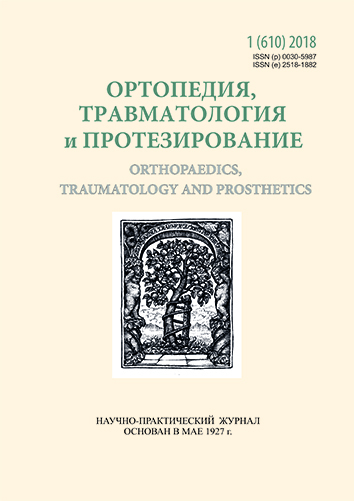Antimicrobial peculiarities of modified magnesium alloy in vitro
DOI:
https://doi.org/10.15674/0030-59872018147-52Keywords:
magnesium, implant, antimicrobial peculiarities, Staphylococcus aureusAbstract
Infection complications after osteosynthesis happen in 5,3–75,4 % of cases, among them posttraumatic osteomyelitis — in 3–24 % after open and 1–7 % — after surgery of closed fractures. The main infectious agents of surgical site infection are Staphylococcus species.
Objective: to assess antimicrobial activity of disintegration products of modified magnesium alloy ML-10 as for S. aureus.
Methods: in the experiment we used modified magnesium alloy ML-10 with modulus of elasticity which is close to cortex bone surface (≈45 GPа) in the form of shavings (0,5 and 1 mg), discs (weight 125 mg, diameter 5 mm, height 3 mm) and cylinders (weight 750 mg, diameter 5 mm, length 18 mm). Shavings and discs were placed into test tubes with Mueller-Hinton broth (рН 7,4), and discs and cylinders — into Mueller-Hinton agar. As test microbial agent we used culture of standard reference S. aureus ATCC 25923 (American Type Culture Collection).
Results: it was shown that products of disintegration of modified magnesium alloy ML-10 have bacteriostatic effect and significant antimicrobial activity as for test infection agent S. aureus ATCC 25923, they suppress its growth in liquid environment during three days. Such effect was conducted by products of disintegration of mentioned alloy due to electric and chemical reactions and creation of alkaline PH environment (from 7,4 to 9,6). Disintegration products of modified magnesium alloy ML-10 can diffuse in dense nutrient and suppress the growth of S. aureus.
Conclusions: it was confirmed that modified magnesium alloy ML-10 can be used for implant production. There is unique possibility to prevent the growth of S.aureus which is the main infection agent of implant-associated infection.
References
- Zorya, V. I. (2002).Воne cement osteosynthesis of fractures of tubular bones in persons with osteoporosis. Abstract’s book of VII Congress of Traumatologists-Orthopedists of Russia. Tomsk: STT, 2, 330–331. (in Russian)
- Akhtyamov I. F., & Kuzmin I. I. (2006). Errors and complications of hip arthroplasty. Kazan, OCP. (in Russian)
- Zimmerli, W., & Trampuz, A. (2012). Biomaterial-associated infection: a perspective from the clinic. Biomaterials Associated Infection, 3-24. doi: https://doi.org/10.1007/978-1-4614-1031-7_1
- Owen, M. A. (2000). Use of the Ilizarov method to manage a septic tibial fracture nonunion with a large cortical defect. Journal of Small Animal Practice, 41(3), 124-127. doi: https://doi.org/10.1111/j.1748-5827.2000.tb03179.x
- Zimmerli, W. A., Trampuz, A., & Ochsner, P. E. (2004). Prosthetic-joint infections. New England Journal of Medicine, 351(16), 1645-1654. doi: https://doi.org/10.1056/nejmra040181
- Brady, R. A., Calhoun, J. H., Leid, J. G., & Shirtliff, M. E. (2009). Infections of orthopaedic implants and devices. In: Shirtliff, M. E., & Leid, J. G. (ed.), Biofilms and devicerelated infections (pp. 15-56). Springer.
- Stewart, P. S., & William Costerton, J. (2001). Antibiotic resistance of bacteria in biofilms. The Lancet, 358(9276), 135-138. doi: https://doi.org/10.1016/s0140-6736(01)05321-1
- Gomes, F., Leite, B., Teixeira, P., & Oliveira, R., (2011). Strategies to control Staphylococcus epidermidis biofilms. In: A. Méndez-Vilas (ed.), Science against microbial pathogens: communicating current research and technological advances (pp. 843–852). FORMATEX.
- Chornyi, V. N., Yatsun, E. V., & Golovakha, M. L. (2013). Prospects for the use of biodegradable, magnesium alloys in osteosynthesis. Collection of scientific works of the Ukrainian Military Medical Academy. "Problems of Military Healthcare", 36, 141–148. (in Russian)
- Shkolnikova, M. A. (2002). Metabolism of magnesium and the therapeutic value of its drugs. Moscow : Medpraktika. (in Russian)
- Robinson, D. A., Griffith, R. W., Shechtman, D., Evans, R. B., & Conzemius, M. G. (2010). In vitro antibacterial properties of magnesium metal against Escherichia coli, Pseudomonas aeruginosa and Staphylococcus aureus. Acta Biomaterialia, 6(5), 1869-1877. doi: https://doi.org/10.1016/j.actbio.2009.10.007
- Chornyi, V. N., Yatsun, E. V., Golovakha, M. L., & Belenichev, I. F. (2013). Investigation of the toxic effects of the production of the original magnesium alloy biodegradation in an experim ent on rats. Collection of scientific works of the Ukrainian Military Medical Academy. "Problems of Military Healthcare", 36, 152–158. (in Russian)
- Golovakha, M., Belyenichev, I., Zhernovaya, G., Chorny, V., & Yatsun, Y. (2014). Experimental assessment of systemic toxicity of implants on magnesium alloy base. Orthopaedics, Traumatology and Prosthetics, 3, 10-15. doi: https://doi.org/10.15674/0030-59872014310-15 (in Russian)
- Lock, J. Y., Wyatt, E., Upadhyayula, S., Whall, A., Nuñez, V., Vullev, V. I., & Liu, H. (2013). Degradation and antibacterial properties of magnesium alloys in artificial urine for potential resorbable ureteral stent applications. Journal of Biomedical Materials Research Part A, 102(3), 781-792. doi: https://doi.org/10.1002/jbm.a.34741
- Zeleniuk, Yu. O., Shalomeev, V. A., & Tsvirko E. I. (2014). Influence of silver doping on the properties of magnesium alloy ML-10. Metallurgy and metal processing, 1, 35–39. (in Russian)
Downloads
How to Cite
Issue
Section
License
Copyright (c) 2018 Vadim Chorny, Yevgen Yatsun, Nataliya Polishchuck, Аleksandr Kamyshnyі, Maksym Golovaha

This work is licensed under a Creative Commons Attribution 4.0 International License.
The authors retain the right of authorship of their manuscript and pass the journal the right of the first publication of this article, which automatically become available from the date of publication under the terms of Creative Commons Attribution License, which allows others to freely distribute the published manuscript with mandatory linking to authors of the original research and the first publication of this one in this journal.
Authors have the right to enter into a separate supplemental agreement on the additional non-exclusive distribution of manuscript in the form in which it was published by the journal (i.e. to put work in electronic storage of an institution or publish as a part of the book) while maintaining the reference to the first publication of the manuscript in this journal.
The editorial policy of the journal allows authors and encourages manuscript accommodation online (i.e. in storage of an institution or on the personal websites) as before submission of the manuscript to the editorial office, and during its editorial processing because it contributes to productive scientific discussion and positively affects the efficiency and dynamics of the published manuscript citation (see The Effect of Open Access).














